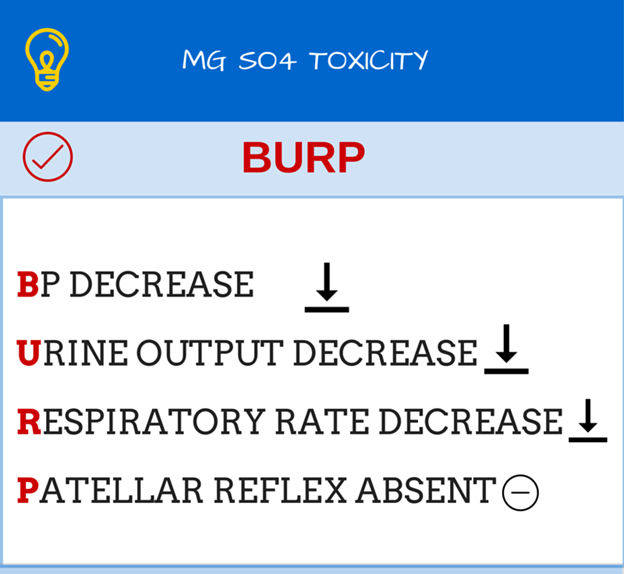A nurse is caring for a client with severe pre-eclampsia who is receiving magnesium sulfate.
Which of the following findings would indicate magnesium toxicity and require immediate intervention?
Urinary output of 25 mL/hour
Respiratory rate of 14 breaths/minute
Deep tendon reflexes 1+
Serum magnesium level of 6 mg/dL
The Correct Answer is A
A. Urinary output of 25 mL/hour. This indicates magnesium toxicity and requires immediate intervention because it means the kidneys are not functioning properly and magnesium is not being excreted. Magnesium toxicity can cause life-threatening complications such as respiratory depression, cardiac arrest, and coma.
B. Respiratory rate of 14 breaths/minute is normal and does not indicate magnesium toxicity. A respiratory rate of less than 12 breaths/minute or more than 20 breaths/minute would be abnormal and require further assessment.
C. Deep tendon reflexes 1+ are normal and do not indicate magnesium toxicity. A loss of deep tendon reflexes or clonus would indicate magnesium toxicity and require immediate intervention.
D. Serum magnesium level of 6 mg/dL is within the therapeutic range for preeclampsia and does not indicate magnesium toxicity.
The therapeutic range for preeclampsia is 4 to 7 mg/dL. A serum magnesium level of more than 8 mg/dL would indicate magnesium toxicity and require immediate intervention.

Nursing Test Bank
Naxlex Comprehensive Predictor Exams
Related Questions
Correct Answer is A
Explanation
Report any headache that is not relieved by acetaminophen.This is because a headache that persists despite taking pain medication can be a sign of increased blood pressure or brain swelling, which are serious complications of preeclampsia.
Choice B is wrong because some vaginal bleeding for up to 6 weeks postpartum is normal and expected for any woman who has given birth, regardless of whether she had preeclampsia or not.
Choice C is wrong because resuming sexual activity as soon as you feel comfortable is also a normal recommendation for any woman who has given birth, unless there are other medical reasons to avoid it.
Choice D is wrong because drinking at least 3 liters of fluid per day to prevent dehydration is not necessary for a woman who had preeclampsia.In fact, drinking too much fluid can worsen the swelling and fluid retention that are common in preeclampsia.
Correct Answer is C
Explanation
This is because bed rest can lower blood pressure and improve blood flow to the placenta and the fetus.The left lateral position reduces pressure on the inferior vena cava, a large vein that carries blood from the lower body to the heart.
Choice A is wrong because magnesium sulfate is used to prevent seizures in severe preeclampsia or eclampsia, not mild preeclampsia.
Choice B is wrong because monitoring the fetal heart rate and movement is important, but not the priority for this client.
Choice D is wrong because educating the client about the signs of eclampsia is not urgent and may not prevent the progression of preeclampsia.Some signs of eclampsia are severe headaches, blurred vision, nausea, vomiting, abdominal pain and seizures.
Whether you are a student looking to ace your exams or a practicing nurse seeking to enhance your expertise , our nursing education contents will empower you with the confidence and competence to make a difference in the lives of patients and become a respected leader in the healthcare field.
Visit Naxlex, invest in your future and unlock endless possibilities with our unparalleled nursing education contents today
Report Wrong Answer on the Current Question
Do you disagree with the answer? If yes, what is your expected answer? Explain.
Kindly be descriptive with the issue you are facing.
